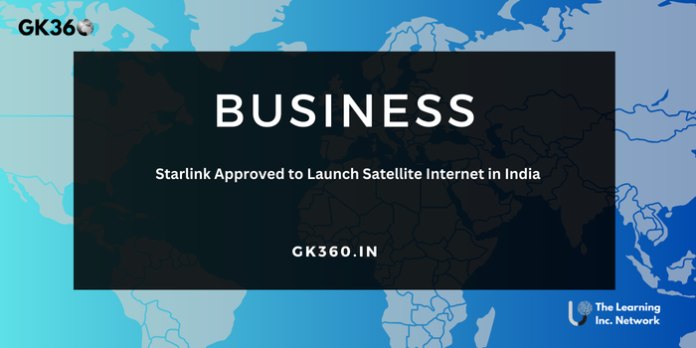Starlink Approved to Launch Satellite Internet in India: A New Era of Digital Connectivity
In a historic move set to reshape India’s internet landscape, Starlink, the satellite internet division of SpaceX led by billionaire entrepreneur Elon Musk, has officially secured the Indian government’s approval to offer its satellite-based internet services across the country. This milestone, following nearly three years of regulatory hurdles, positions Starlink to deliver high-speed broadband to India’s most remote and underserved regions, bringing the nation a step closer to universal digital connectivity under the Digital India mission.
With its powerful constellation of low Earth orbit (LEO) satellites, Starlink aims to bridge the digital divide in rural India, offering reliable internet access where traditional infrastructure has struggled. The approval comes with a Letter of Intent (LoI) for a GMPCS (Global Mobile Personal Communication by Satellite) licence, marking a critical regulatory greenlight that unlocks the path for Starlink’s Indian operations.
Table of Contents
- What is Starlink? A Brief Overview
- India Approves Starlink’s GMPCS Licence: Key Details
- Starlink’s 3-Year Journey to Approval
- Understanding the Satellite Spectrum Debate
- New Satcom Rules: Data Security, NavIC Integration & More
- How Starlink Could Bridge India’s Digital Divide
- Starlink vs Jio & Airtel: The Competitive Landscape
- Opportunities & Challenges for Satellite Internet in India
- FAQs About Starlink’s Launch in India
- Conclusion: India’s Leap Toward Universal Connectivity
What is Starlink? A Brief Overview
Starlink is a satellite-based broadband internet service developed by SpaceX. Using a growing network of over 7,000 low Earth orbit (LEO) satellites, Starlink delivers high-speed internet globally, particularly targeting remote and underserved areas where terrestrial internet infrastructure is inadequate.
Unlike traditional satellite providers operating from geostationary orbit, Starlink’s LEO satellites orbit much closer to Earth, reducing latency and improving connection speeds. The service has already expanded in countries like the U.S., U.K., and Australia, and now sets its sights on India’s vast potential market.
India Approves Starlink’s GMPCS Licence: Key Details
In a landmark regulatory decision, India’s Department of Telecommunications (DoT) issued a Letter of Intent (LoI) to Starlink, granting it permission to pursue a GMPCS licence. This licence allows Starlink to operate satellite-based communication services under Indian regulations.
Key highlights of the approval include:
- Permission to operate satellite internet across India’s urban, rural, and remote areas.
- Clearances following meetings between Elon Musk, Prime Minister Narendra Modi, and Commerce Minister Piyush Goyal.
- A major step toward boosting satellite broadband penetration in India’s challenging geographies.
This approval places Starlink in direct competition with India’s major telecom giants like Reliance Jio and Bharti Airtel, both of whom are also preparing their own satellite internet offerings.
Starlink’s 3-Year Journey to Approval
Starlink filed its initial application for a GMPCS licence almost three years ago, aiming to bring satellite broadband to underserved Indian regions. Its mission: to bridge the digital divide by offering affordable, reliable internet access to places where fiber optics and mobile networks have failed to reach.
However, the path wasn’t smooth. Starlink faced:
- Opposition from telecom rivals concerned about spectrum allocation methods.
- Delays from regulatory debates on whether satellite spectrum should be administratively allocated or auctioned.
- Calls for strict data localisation and security compliance from Indian authorities.
After prolonged consultations and policy reviews, the government opted for administrative spectrum allocation, recognizing the global, shared nature of satellite frequencies.
Understanding the Satellite Spectrum Debate
Starlink’s approval journey wasn’t without controversy. A major point of contention was how India should allocate satellite spectrum—a critical resource for satellite internet providers.
The two opposing sides:
- Starlink’s position: Satellite spectrum should be administratively allocated due to its shared, global nature.
- Opposition (led by Reliance Jio): Spectrum should be auctioned, similar to terrestrial telecom spectrum.
Ultimately, the Indian government chose administrative allocation, aligning with international practices to prevent frequency interference and foster seamless cross-border coordination. This decision has cleared a key hurdle for Starlink and other global satellite internet operators.
New Satcom Rules: Data Security, NavIC Integration & More
Alongside Starlink’s approval, the Department of Telecommunications (DoT) rolled out updated satellite communication (satcom) guidelines, setting the regulatory framework for satellite operators.
Key provisions include:
- Local Manufacturing Mandate:
- Satellite operators must ensure 20% local sourcing of ground infrastructure and hardware within 5 years.
- Data Localisation Rules:
- All user data must be stored and processed within India’s borders.
- Security Measures:
- Real-time traffic monitoring systems and mechanisms to block communications in case of emergencies are mandatory.
- NavIC Integration Deadline:
- By 2029, all satellite operators must adopt India’s indigenous NavIC navigation system, reducing reliance on foreign systems.
- DNS & Gateway Rules:
- DNS resolution and user traffic routing must remain inside Indian territory to safeguard data sovereignty.
These rules aim to balance foreign investment with national security and domestic industry promotion.
How Starlink Could Bridge India’s Digital Divide
India’s geography poses unique challenges for internet connectivity: mountainous regions, remote islands, and sparsely populated rural areas often lack reliable infrastructure. Here’s where Starlink’s satellite internet could transform the landscape:
- Remote Connectivity: Bringing high-speed internet to villages, schools, and healthcare centers beyond terrestrial network reach.
- Education Boost: Enabling online education access in rural areas, empowering students with digital learning tools.
- Healthcare Access: Supporting telemedicine services for underserved communities.
- Entrepreneurship: Opening doors for e-commerce and remote work in small towns and villages.
With the Digital India mission aiming for universal digital access, Starlink’s entry could be a game-changer for inclusive growth.
Starlink vs Jio & Airtel: The Competitive Landscape
With Starlink entering India’s market, it will compete directly with:
- 🔹 Reliance Jio’s satellite division (JioSpaceFiber)
- 🔹 Bharti Airtel-backed OneWeb
Competitive advantages for Starlink:
- Already operational in over 60 countries.
- Largest LEO satellite constellation globally.
- Proven low-latency technology.
However, Jio and Airtel may leverage:
- Stronger local manufacturing networks.
- Existing telecom infrastructure for integration.
- Better political and regulatory connections.
The competition is expected to drive innovation, pricing improvements, and expanded coverage, ultimately benefiting consumers.
Opportunities & Challenges for Satellite Internet in India
Opportunities:
- Expand internet access to 250 million+ underserved people.
- Boost digital literacy and e-governance.
- Stimulate local electronics manufacturing under Atmanirbhar Bharat.
Challenges:
- Affordability concerns: Can satellite internet match terrestrial pricing?
- Awareness & adoption barriers in rural regions.
- Integration with India’s data localisation and security regulations.
Starlink’s success will depend on navigating these challenges while delivering affordable, reliable service.
9️⃣ FAQs About Starlink’s Launch in India
- What is a GMPCS licence?
A Global Mobile Personal Communication by Satellite (GMPCS) licence allows satellite operators to provide voice and data services directly to users via satellite. - When will Starlink start services in India?
Starlink is expected to start rolling out services in late 2025 or early 2026, following infrastructure setup and compliance clearances. - How will Starlink’s internet compare to Jio and Airtel?
Starlink offers global coverage with low-latency satellite connections, while Jio and Airtel plan to integrate satellite services with their existing terrestrial networks. - Will Starlink be available in rural India?
Yes. Starlink’s focus is to connect underserved and remote regions, including rural villages, islands, and mountainous areas. - Will Starlink’s internet be affordable in India?
Pricing details are not announced yet, but regulatory pressure and competition may push Starlink to offer lower prices tailored to the Indian market.
Conclusion: India’s Leap Toward Universal Connectivity
The Indian government’s decision to grant Starlink a Letter of Intent for a GMPCS licence marks a watershed moment in India’s digital journey. By leveraging a powerful constellation of 7,000+ LEO satellites, Starlink is poised to bridge the connectivity gap in rural, remote, and underserved regions, aligning with the Digital India mission.
With strict regulations balancing data sovereignty, national security, and local manufacturing, India has laid a roadmap for satellite internet to complement terrestrial networks and unlock new opportunities for digital empowerment.
As Starlink gears up to launch, India’s telecom landscape is set for a transformation—toward a more connected, competitive, and digitally inclusive future.
Key Takeaways Table
| Aspect | Details |
| Approval Milestone | India grants Starlink a GMPCS licence after 3 years of regulatory processes. |
| Coverage Goal | Aim to provide high-speed satellite internet to rural, remote, and underserved regions. |
| Competitive Landscape | Competing with Reliance Jio’s JioSpaceFiber and Bharti Airtel-backed OneWeb. |
| Key Advantages | Largest LEO satellite network, proven global low-latency services, quick deployment. |
| Regulatory Requirements | Data localisation, NavIC integration by 2029, 20% local sourcing mandate, DNS rules. |
| Challenges | Pricing competitiveness, rural adoption awareness, security compliance. |
| Expected Rollout | Services expected by late 2025 or early 2026 post infrastructure and compliance setup. |





